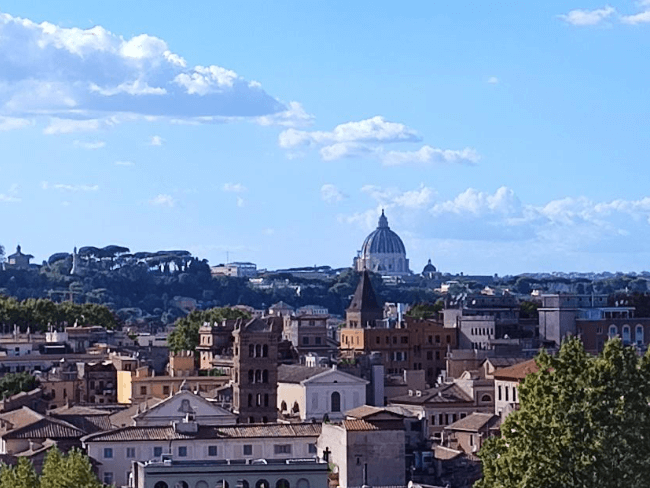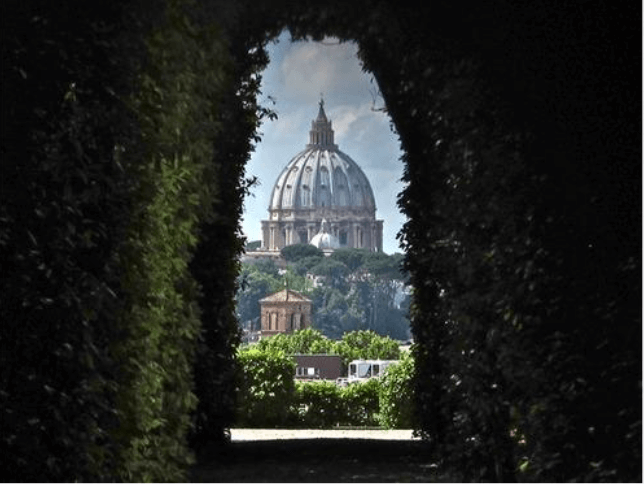1.Giardino degli aranci
The Orange Trees Garden is the name used in Rome to describe the Parco Savello.
The Savello Park stands on the Aventine hill, in the area of the ancient fortress built by the Savelli family towards the end of the 13th century at the church of Santa Sabina; the fortress was built on a pre-existing 10th century castle belonging to the Crescenzi.
The large medieval walls of the fortress now surround the Park or Orange Garden, a small rectangular garden very popular because from the belvedere overlooking the river you can enjoy a splendid view of Rome from the bend of the Tiber to St. Peter’s Basilica.
The trees that give it its name were planted in memory of San Domenico, who founded the convent right here in the thirteenth century: the orange at which the saint preached is kept in the nearby cloister of S. Sabina and is still visible through a hole in the wall of the church porch.
The park, characterized by a symmetrical layout with a median avenue aligned with the belvedere, was built in 1932 on a project by the architect Raffaele De Vico, who enhanced the space enclosed between the ancient walls. In the enclosure wall, on the side opposite the side wall and the apse of Santa Sabina, the traces of the towers and the drawbridge of the castle are clearly recognizable.
The walls bear the signs of a subsequent refurbishment of the area, carried out at the end of the sixteenth century by the architect Domenico Fontana on behalf of Sixtus V. In addition to the walls, the thirteenth-century castle and its subsequent extensions only remain a few granaries and warehouses underground, while the building was almost completely demolished in 1613.

Leaving the Orange Garden and turning right, you reach Piazza dei Cavalieri di Malta, designed by the famous engraver Giovan Battista Piranesi in 1765. From the lock of the door that leads to the Villa dei Cavalieri, you can see Saint Peter’s dome, framed by the garden hedges.

The so-called Quartiere Coppedè, a complex of palaces and small villas in the Trieste district, is recognizable at a glance for its magnificence. It is an artistic-architectural experiment that combines Art Nouveau, Art Deco, Gothic and Medieval styles with references to Greek and Roman art. It owes its name to the architect Gino Coppedè, who built it between 1915 and 1927.
A large, richly decorated arch, hung with a wrought-iron chandelier on Via Tagliamento, marks the entrance to the buildings facing Piazza Mincio. At the center of the square is the Fontana delle Rane (Fountain of Frogs), probably inspired by the one of turtles created by Bernini in the Jewish ghetto. The fountain is famous for the Beatles’ bath after one of their concerts at the Piper Club.
Several noteworthy buildings overlook the square, such as the Villino delle Fate, consisting of three asymmetrical buildings whose paintings pay homage to the cities of Florence, Rome and Venice, and the Palazzina del Ragno covered with dragons, monsters and a knight with the inscription Labor, in a tribute to work. The Coppedè District was chosen as a film set by director Dario Argento for two of his most famous films “Inferno” and “The Bird with the Crystal Plumage” and by other directors as well.

Dubai: Jumeirah Lake Towers 2618 PO BOX: 454795 Dubai, United Arab Emirates
© 2024 Created By sandboxcreatives.fr
We noticed you're visiting from United Arab Emirates. We've updated our prices to United Arab Emirates dirham for your shopping convenience. Use Euro instead. Dismiss